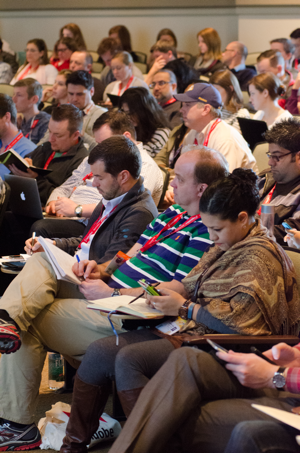When something important that impacts your business happens in the real world, your customers, competitors, and influencers will instantly be talking about it online, sometimes by the thousands. Sound stressful? Don’t worry; that’s a good thing.
Every social media message contains important data. So when you have lots of social media messages, you have big data. And you also have a big opportunity to react in real-time, if you have the tools to understand what the data are telling you.
With billions of monthly active users engaging on social networks, we can now gather a wealth of insight and information. A big data revolution is happening, and what’s most interesting, isn’t the quantity of data. It’s that we can now do something with it.
Our Director of Marketing and Communications, Cameron Uganec, once said, “big data is only valuable if it tells a story.” What stories does the data circling your business tell? Do you know how to find them?
A huge part of this storytelling comes from finding patterns to gather knowledge. Tools that visualize big data help link the massive amount of information together and make some sense of it—Nexalogy is one such resource.
“In five or 10 years’ time, big data will not be a source of competitive advantage, it will just be a necessary part of normal business,” said Eddie Short, UK and EMEA Leader for Data and Analytics at KPMG Management Consulting in a techradar article. “Without exploiting it, a business will die.”
What can we learn from ahead-of-the-curve businesses that are already visualizing data to tell stories, and how can you begin to do the same?
Big data visualization for crowd management
Picture this for a moment: The sun is shining and you’re happily dancing to a new band at one of the world’s largest music festivals: South by Southwest (SXSW).
That’s hard to believe, considering that only moments before, you were standing in a lineup a thousand deep as police and security guards told you that the venue was at maximum capacity. Like everyone else, you paid a lot of money to come see that band. Once the venue went beyond maximum capacity and attendees were to the fences you tweeted about the lineup.
But SXSW’s festival organizers collaborated with Hootsuite for months to plan and strategize how to handle crowd management scenarios just like this. They set up a command center to oversee all digital communications—related to the event and the surrounding area—and relay important messages and instructions to staff on the ground.

But how did they sift through 72,000 event attendee’s social messages to find trending conversations, like the lineup issue, to nip problems in the bud? They used a big data visualization tool, Nexalogy, as an integrated app with Hootsuite’s listening, engagement, and team collaboration functionality.
Before the event, Hootsuite and SXSW organizers worked together to create a keyword search list related to the event, for example “crowd,” “police,” and “SXSW.” While you were in the lineup, the organizers began to see a trend forming on Twitter in the Nexalogy app around similar keywords.
Within seconds, the organizers dispatched more security, shuffled around set times to add another big act at a different location, and radioed volunteers to help calm the crowd. Using Hootsuite search streams, the social media team jumped into all related conversations, apologized to angry fans, and appeased the situation by directing them to a pop-up concert at another location—the one you’re theoretically dancing at now.
Use big data to gauge new markets and track campaign success
Visualizing social data to tell a story of what’s happening on the ground is not only important for large-scale-event organizers, but for businesses looking to penetrate new markets or launch campaigns, products, and services. Big data is key for gauging and anticipating how an audience will react to a product or service. It also helps source influencers who can help amplify brand messages in new markets.
While tools like Nexalogy is key to visualizing trends and finding influencers, Hootsuite takes it to the next step by engaging with customers, influencers, and others talking about trending keywords. This is especially helpful while tracking recently launched campaigns through keywords and hashtags as the conversations around them grow. Which messages resonated most with your following? Who were the key influencers that connected with your campaign?
Why big data visualization is so helpful during emergencies
Whether your business is experiencing some sort of PR nightmare online, or your organization is in charge of emergency disaster response, big data visualization is useful for zooming in on the most important and trending conversations taking place at any given time.
For example, during Hurricane Sandy, emergency response teams could see the effects of the storm as it swept across the country from the online messages and conversations about power outages, downed power lines, accidents, and so on.
As more businesses rely on social media for marketing, customer service, and selling, gathering real-time insights will become the standard action, rather than an exception.
